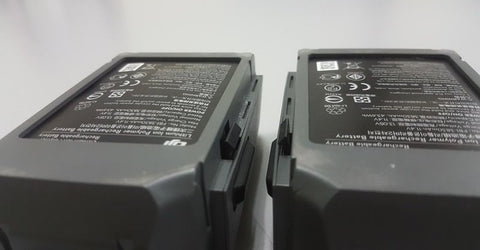Introduction
At Beyond Visuals we fly drones a lot, an activity that has given us a fair bit of experience in dealing with drone related issues, experience that we'd like to share with everyone to ensure that everyone is getting the most out of their drone in a safe, controlled way. In our blog we do our best to provide advice for safe flying both before and after take off, informing you of the potential issues you may encounter and how to solve them. If you haven't read these articles yet and want to know more, you can find them here.
One of the issues we have mentioned before is bloated batteries, often manifesting in the underside of the battery swelling out so that it's no longer flat. Currently, there is much speculation about what leads to batteries becoming bloated, with comments in forums indicating that it may be due to age, overcharging (leaving the battery on the charger long after it has completed a full charge), humidity and temperature, pushing the batteries to the limit etc. Below we've put together our collective experience to help you establish how you can preserve your batteries and what to do in the eventuality of a swollen battery.

Why do Li-on batteries swell?
Unlike Paul Rudd or Cher, lithium ion batteries don't tend to age well, with different components of the battery wearing in different ways throughout the life cycle. These include things like the corrosion of the collector, the decomposition of the electrolyte, structural disorder and decomposition of the cathode, not to mention the formation of 'dendrites', tree-like structures that grow throughout the battery that severely affect usage. All of these things fundamentally effect the electrochemical performance of the battery, leading to shorter battery life, over heating and yup, swelling or bloating of the battery unit.
What do you do with a swollen battery?
Bloated batteries can be dangerous at the best of times, and should be handled and disposed of with care. Exposure to heat can lead to swollen batteries combusting, a situation that everyone clearly wants to avoid. When it comes to droning and drone batteries there is an additional level of danger - swollen batteries can lead to a battery popping out of the drone housing, causing the drone to power off and fall out the sky. Before you start panicking, you should know that this particular circumstance is something of a rarity and doesn't often happen, but it does still occur. The latching mechanisms offer a certain amount of security and can hold on firmly to a battery that is slightly bloated, but pushing a bloated battery past it's limit could result in the above eventuality. If your battery is swollen to any extent, do not use it in your drone and get it replaced, simple as that.

So what should you do to check for bloating? First of all, inspect your batteries regularly, and by this we mean a thorough inspection, particularly looking at the flat underside of the battery to check for any warping or swelling. After you've done this, check your battery cycle count - this can be done by connecting to your drone, navigating to the battery section under the main menu, and scrolling down to check the cycle count. Looking at online forums and our own previous experience, batteries seem to bloat around the 40 cycle count mark, but remember, this depends on your usage, charging habits and environment. Some batteries have made it to a hundred cycles before swelling, whereas others have copped out at 10 - these batteries are most likely defective and you should contact your drone representative to handle the issue accordingly.
The definitive guide to looking after your batteries:
Based on what we've discussed above, have a look at the tips below to maximize your batteries and ensure the safety of your drone flights.
1. Don't leave your batteries on charge - after they have completed the charge cycle, remove them from the charger.
2. Store your batteries in a cool, dry place, away from direct sunlight.
3. Label your batteries after purchasing so that you're aware how long you've used them for, this will help you keep track of them.
4. Inspect on a regular basis, looking at the underside of the battery to check for swelling.
5. If you notice any swelling, do not use the battery. Take it home, check the charge cycle and life span and get in touch with the drone maker to find a solution.
6. Replace your batteries where needed - don't expect them to last forever.
7. If you notice any swelling, do not use the battery. Yes, this point is the same as point 5, but it's worth reiterating to ensure the safe operation of your drone.
Thanks for reading. As always if you have any questions or thoughts, or would like some more information on a particular topic, feel free to get in touch with us through the contact form or by emailing contact@beyondvisuals.hk
See you in the next post!
The Beyond Visuals Team 
